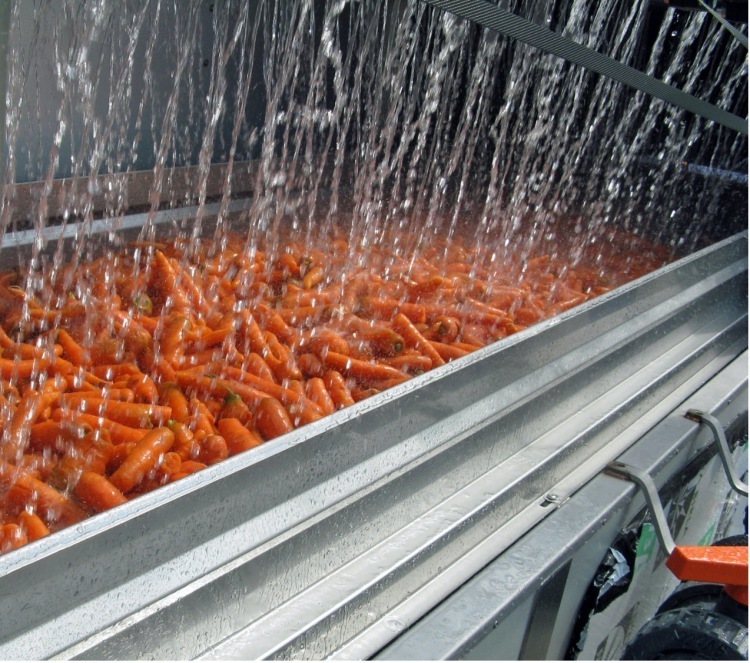- Wash water quality is a critical control point in fresh produce hygiene and must be carefully managed.
- Washing methods vary depending on crop type and include immersion, spraying, brushing, and hydrocooling.
- Recirculated water must be treated and monitored to avoid cross-contamination.
- Hydrocooling is effective but presents microbiological risks if water is not properly managed.
- Red Tractor and EU-derived regulations require documented water risk assessments, testing, and treatment protocols.
Produce washing and cooling
In summary
Postharvest washing of fresh produce
Washing fresh produce after harvest plays a vital role in reducing microbial contamination and preserving quality. The primary goal of postharvest washing is to remove soil, organic matter, and any potential microbial contaminants that may have accumulated during growing, harvesting, and handling. While washing cannot guarantee complete elimination of pathogens, it is a valuable step in reducing microbial load, particularly when implemented alongside other hygiene practices.
For growers in Scotland, where certain pathogens such as Escherichia coli are of particular concern due to their environmental persistence and association with agricultural settings, implementing effective postharvest washing practices is essential. At the same time, economic and sustainability considerations lead to the exploration of water-saving measures, such as recirculated wash systems, which must be carefully controlled to prevent contamination.
Washing methods
Several washing techniques are used depending on the type of produce and the scale of operation. For delicate crops such as leafy greens, herbs, or soft fruit, gentle spray washing or immersion in low-turbulence tanks is typical. These methods are designed to avoid damaging the product while removing contaminants. Multiple rinse stages are often employed, with the final rinse using potable-quality water to ensure any remaining microbes are removed.
For firmer produce such as root vegetables (carrots, potatoes), abrasive brushing or drum washing may be used. These systems use mechanical action to dislodge soil and debris, providing a greater level of physical cleaning. Studies have demonstrated that such systems can reduce microbial counts more effectively than spraying alone, particularly when combined with appropriate sanitisation.
Hydrocooling and cooling alternatives
Hydrocooling is another commonly used postharvest intervention. It involves immersing or showering produce in chilled water to rapidly remove field heat, slowing metabolic processes and extending shelf life (figure 1). Because this process involves direct water contact with the edible portion of the crop, often just prior to packaging or sale, the microbiological quality of the water is critical.
Ideally, hydrocoolers should use potable water. However, in practice, water in these systems is frequently recirculated for up to a week before replacement. This practice introduces a risk of microbial build-up and cross-contamination if the water is not routinely monitored and treated. Proper management involves the use of sanitisers, routine microbial testing (e.g. for generic E. coli as an indicator), and clear protocols for water replacement or treatment.
Figure 1: The removal of field heat from carrots to extend shelf life and reduce crop dehydration (wilt)

Alternative cooling methods, such as vacuum cooling and forced-air cooling, carry a lower microbiological risk because they do not involve direct water contact. Nonetheless, air used in such systems should be filtered and equipment maintained to prevent the introduction of airborne contaminants (2).
Water quality and microbial safety
The quality of water used in washing is a key determinant of the microbial safety of produce. If wash water becomes contaminated, either from previous batches of produce or from the source itself, it can act as a vehicle for spreading pathogens. This is particularly important when water is reused or recirculated.
Best practice involves treating and monitoring recirculated water to maintain hygienic conditions. Parameters such as microbial counts, turbidity, pH, temperature, and disinfectant residuals should be regularly checked. Counterflow designs, where clean water flows opposite to the direction of produce movement, can help reduce the risk of contamination.
The European Food Safety Authority (EFSA), emphasise that wash water must meet potable standards when in direct contact with produce. No detectable E. coli in 100 mL is commonly required as a baseline standard (1).
Regulatory Requirements and Assurance Schemes
In Scotland, postharvest washing falls under the scope of retained EU law, specifically Regulation (EC) No. 852/2004 on the hygiene of foodstuffs. This regulation requires that water used in food processing, including washing produce, must be of suitable quality and not present a contamination risk. For many producers, this means water must meet drinking water standards, especially when in final contact with produce destined to be consumed raw (i.e. ready-to-eat produce).
Red Tractor further mandates that growers carry out a risk assessment of all water sources used in postharvest washing (3). The scheme requires that water used for washing or icing be tested by a laboratory accredited to ISO 17025, and that where water is reused, there must be a documented treatment process in place. These controls are supported by record-keeping and corrective action procedures in the event of a failure.
The regulation and assurance framework also extends to equipment hygiene. Brushes, tanks, flumes, and other wash infrastructure must be cleaned and sanitised on a routine basis. This prevents the development of biofilms, which can harbour pathogens and reintroduce them into the washing process despite apparent water cleanliness.
Conclusion
Washing is an essential component of postharvest hygiene management for fresh produce. It contributes to both food safety and product quality, particularly when water quality is well controlled and washing methods are tailored to the crop. Proper implementation of postharvest washing and, where applicable, cooling, supported by monitoring, regulation, and assurance schemes, is a critical control point for growers committed to producing safe, high-quality food.
